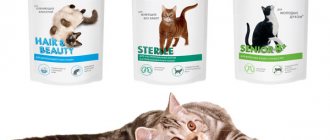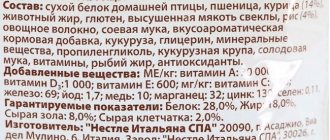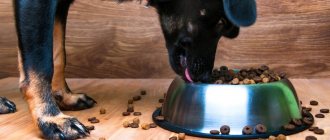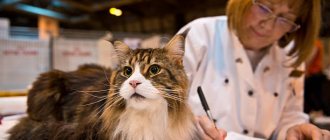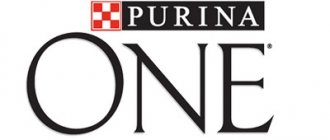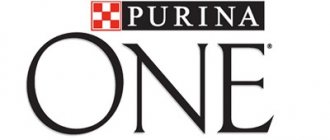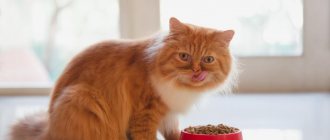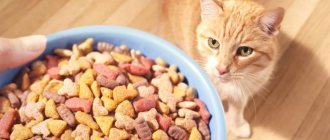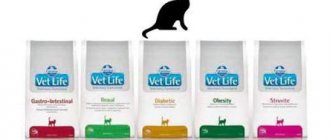Caring cat owners know that domestic cats not only need shelter and care, but also a complete and balanced diet.
The realities of dynamic city life required a new look at the organization of pet food. So in the middle of the last century, the industry began to produce long-lasting cat food.
Nowadays, this industry is represented by many manufacturers of dry food and canned food. One of the reputable manufacturers of such products is.
Manufacturer
Hill's official website: www.hillspet.com.
Hill's Pet Nutrition was founded in 1939 by veterinarian Mark Morris, who believed that animal health was directly related to nutrition. Initially, Hills brand products were developed for dogs, but in the late 1960s the first food for cats appeared.
Over the 80 years of its existence, the company has been constantly working on the quality of its products, improving formulas and creating new types and lines. Food for cats and dogs under the Hill's brand is known in both hemispheres and is supplied to most countries. The factories where the feed is produced are located in the Netherlands and the USA. In Russia, the company cooperates with many distributors; the choice of partner depends on the region of the country.
General characteristics, country of origin
Hill's dry food for dogs and cats has been on the market since the 40s of the last century. Scientists and veterinarians take part in the development of diets, which helps to ensure an individual approach to the animal, taking into account all the characteristics of its body at different stages of life. The Hills Research Center is located in the USA, Kansas, and there are numerous representative offices in almost every country.
Types of feed
Hills brand products can be divided into 2 main types:
- Everyday food designed to feed cats every day;
- A therapeutic diet developed for pets who need a gentle menu due to illness or during the recovery period.
Products for feeding cats are divided into dry diet and wet food. Release forms:
- Dry granules, packaged in packages of various sizes;
- Canned mousses in metal cans;
- Small bags, or pouches, with pieces of meat.
How did laboratory research turn into premium food?
Research to create a product that cures diseases began in 1928 with the opening of a clinic in the USA. Mark Morris, an honored specialist, received visitors with pets suffering from external factors. The story of a man who came with a German shepherd suffering from impaired renal function caused resonance. After much research, the veterinarian came to the conclusion: improper nutrition destroys the dog from the inside. Having released the first medicinal food, mothballing it, Morris contributed to the activity.
In 1948, the specialist signed a cooperation contract with (Hill Packing Company), and the first batch of canned food was produced (Hills Pet Nutrition). The food was specialized for sick pets, and a research laboratory was opened in the USA. His father's business is continued by Morris Jr., producing a type of food for healthy pets - Hills Science Plan.
Line of medicinal feeds
Despite the fact that industrially produced food is produced by dozens of manufacturers, only a few companies have a special treatment line. Hills' wide range of products designed to feed sick cats has earned the trust of veterinarians and owners.
Hill's Prescription Diet line includes more than 10 types of food. Each of which can only be recommended by a veterinarian in accordance with the identified pathology of the animal. The duration of feeding is also agreed upon by the doctor.
Food recommended for kidney dysfunction and urological diseases:
- SD – used for the prevention and treatment of urinary tract diseases
- CD - used in the treatment of urolithiasis and cystitis of various etiologies.
- KD - prescribed for renal failure and other nephrological pathologies.
- G.D. – intended for animals with Chronic renal failure is combined with pathologies of the heart muscle.
Veterinary foods prescribed for diseases of the gastrointestinal tract and liver:
- LD – used for liver failure and various liver lesions.
- ID – recommended for diseases of the digestive system .
- W.D. – food with a wide spectrum of effects, useful for diabetes, constipation, colitis and intestinal inflammation.
Excess weight is harmful for domestic cats, so medicinal foods are also necessary to correct it:
- MD – designed for obese animals, as well as for cats with an excess of glucose in the blood.
- RD – dietary food .
- Metabolic (Metabolic) - prescribed to speed up metabolism and normalize weight.
- Metabolic + Urinary – carries out prevention of urolithiasis in combination with maintaining normal weight.
Other types of medicinal feeds:
- YD – necessary for the treatment of thyroid diseases.
- JD – recommended for the development of joint pathologies .
- TD – used to treat diseases of the oral cavity .
- ZD – intended for animals prone to allergies .
- AD – designed for speedy recovery of cats after surgery, severe diseases and underweight.
Hill's Prescription Diet food on Yandex Market
Is the composition of the Hills anti-allergenic food surprising?
Hill's hypoallergenic dog food is enviable - the company's range is wide. Divided into dry granules/canned food, similar elements are present. Manufacturers assure that pets suffering from food inability to accept food in the body will be happy to taste Hills. How we managed to achieve the desired result:
| Element | Positive influence | By-effect |
| Chicken and turkey meal | The dose of protein is greater than in natural chicken. | Use of bones and skin. |
| Corn/wheat | Fatty acids affect the health of the coat and skin, sources of energy. | Animals do not digest grains well and cause weight gain. Cause allergies. |
| Sugar beet | Cell regeneration, improvement of intestinal function, source of calcium. | Cause allergies. |
| Taurine | Speeds up metabolism. | — |
| Tomato pomace | A source of fiber, improves the functioning of the digestive tract. | — |
| Minimal Processed Whole Grain Rice | Dietary fiber normalizes the functioning of the gastrointestinal tract. | — |
The presence of allergens is confusing - hypoallergenic products contain allergens. However, when selecting food, experts find out whether there is any individual intolerance.
Food for every day
The Hills company produces 3 lines of food for daily consumption:
- Science Plan – a diet developed for completely healthy animals and taking into account age characteristics, breed size and special needs.
Hill's Science Plan food
- Nature's Best – feed of improved composition, consisting only of products that are healthy for animals. Components that potentially provoke allergies are excluded from the formula.
Hill's Nature's Best food
- Ideal Balance – completely balanced food for cats. Some of the products in this line include brown rice, a grain that is most natural for cats. Other foods are completely grain-free.
Hill's Ideal Balance food
Important! Grain-free foods are not always well absorbed by cats and can cause constipation. Despite the prevailing opinion that such a diet is optimal for pets, it is important to closely monitor the animal’s reaction and well-being.
Dry food forms the basis of the cat's menu; in addition to it, the manufacturer supplies the market with wet canned food and meat pieces in pouches.
Opinion of veterinarians, owners and pets
The quality of hypoallergenic dog food can be assessed from Hills reviews of specialists/owners who have tested the food on their pets:
“Hills dog food will appeal to pets who are not allergic to corn and wheat, which are present in the composition. Natural products, manufacturers use meat flour, which is impossible to verify. However, the feed manufacturer has been on the market for a long time, there is no reason not to believe it. In addition to meat flour, the necessary microelements and vitamins are present - the basics of a dog’s diet are preserved.
The Hills line of anti-allergenic dry dog food includes medical nutrition - Hills Prescription Diet. The components treat dogs - from gastrointestinal problems to cardiovascular diseases. Based on practice, animals that had problems and switched to Hills got rid of their problems. Thanks to hypoallergenic dog food.”
“I am the owner of a Chihuahua dog who is allergic to chicken, which is on the list of popular food additives. Allergies of various types - itching, crusts on the back, diarrhea. We lost hope and, after much effort, looked for a veterinarian who recommended Hills Science Plan for adult dogs – a “pill” for allergies.
- Hills granules are medium size, a small dog can chew them and brush their teeth.
- The smell is not chemical, weak.
- Practical packaging.
- Absence of the dog-hated chicken.
- The packaging indicates the ratio “number of granules/weight”. The little cup suffered - diarrhea, running eyes, spots on the skin. A month of use - the condition of the skin and coat has improved, I have not gained weight, there are no more tears in my eyes!
- I bought a 3kg package of food, enough for 3 months. Economical, surprised by the price.
A solid “A” goes to the anti-allergenic dog food.”
Cases of exacerbation of allergies to various products are not excluded, so do not buy the product yourself, consult your doctor. You cannot guarantee good consequences!
Specialized feed
Hill's has developed specialized food for cats with special needs. This is also an everyday cat diet, but it is ideal if the cat is prone to allergies, is neutered or has fluffy hair.
For sterilized cats and neutered cats
After sterilization or castration, it is recommended to transfer animals to special food. Cats after such operations require a lower percentage of proteins and fats. Hill's Young Adult Neutered - dry kibble, mousse and meat kibble in several flavors for neutered animals. Hill's is included in the rating of the best food for neutered cats.
Hypoallergenic food
If a serious allergy occurs, your veterinarian will recommend a special diet for the duration of treatment. For pets with a tendency to such reactions, Hills has developed a hypoallergenic line, Nature's Best , from which allergens (corn, rice, chicken) are completely excluded.
Hill's for sedentary cats
Hill's Science Plan Indoor Cat Adult is a diet designed for cats that spend most of their time indoors. Such animals are prone to weight gain, so the feed is low in fat and carbohydrates, and also contains minerals that have a beneficial effect on the urinary tract.
For animals with sensitive skin
Hills Science Plan Feline Adult Sensitive Skin is useful for animals with skin problems, as well as dull and brittle hair. The specialized composition of the food eliminates itching, relieves inflammation and supplies the blood with substances necessary for shiny fur and improved skin condition.
For pets with long hair
Hills Science Plan Feline Adult Hairball Control - food for long-haired cats. In the process of washing, cats eat dead hairs that stick together in the stomach cavity and form bezoars. A fiber complex has been added to the diet formula, which facilitates the removal of hairs from the gastrointestinal tract naturally.
For dental care
Hill's Science Plan Adult Oral Care helps remove plaque and prevent tartar. Fangs are cleaned due to the special consistency of granules that do not crumble when the cat eats. The low percentage of calcium and proteins prevent the entry into the oral cavity of components that cause plaque on the teeth.
For pets with sensitive digestion
Hill's Science Plan Adult Sensitive Stomach is a food containing fiber necessary to maintain the natural microflora of the intestinal tract and improve peristalsis. The rice and eggs in the composition allow the body to easily absorb and completely digest the eaten granules.
For overweight cats
Hill's Science Plan Perfect Weight Adult - food for cats that have begun to gain extra pounds. This food, as the basis of the diet, allows you to maintain weight balance and eliminate fat layers. The formula is designed in such a way that the animal quickly becomes satisfied after eating a small portion. It also contains a high percentage of fiber and low fat content. L-carnitine stimulates metabolism.
What food to choose
With such a variety of diets, it is very important to choose the right food that will saturate your dog’s body and help restore its health. First of all, you should take into account weight, age and the presence of any diseases, and also do not forget about the pet’s taste preferences. We have compiled a list of Hills products for daily nutrition, based on the size of the animal.
For small breeds
For dogs weighing up to 10 kg, the Science Plan series includes the following diets:
- Hills Science Plan Puppy Healthy Development Mini. It comes in two flavors - lamb with rice and chicken.
- Hills Science Plan Canine Small Adult and Miniature. Available in poultry flavor.
For medium breeds
If your dog weighs from 10 to 25 kg, then you can choose the right diet from the following diets: Hills Science Plan Canine Adult Advanced Fitness. Your choice of flavors is tuna with rice, chicken.
For large breeds
If you are the happy owner of a large breed dog weighing more than 25 kg, then choose the following food for it:
- Hills Science Plan Canine Adult Advanced Fitness Large Breed. Available in lamb with rice and chicken flavors.
The largest dogs include such breeds as: St. Bernard, Spanish and Tibetan Mastiff, African Boerboel, Newfoundland, Great Dane, Leonberger and Moscow Watchdog.
Classification by age criterion
Small kittens grow, develop and actively spend energy, so they need a high percentage of protein, which is a building material for growth. Adult cats need a source of energy, and older cats, due to reduced activity, need a reduced fat content.
- From 3 weeks to 1 year. The Hills brand sells a separate series designed specifically for active kids. The food is high in protein and calcium, which is essential for strengthening growing bones. The taste variability is not so wide; for older cats, even for the most picky kittens, it is possible to choose healthy and balanced dry food or airy mousse. The food is included in our rating of premium and super premium food for kittens.
- From 1 year to 6 years – for adult animals. Hills food, in addition to specialized products, offers an extensive range of flavors, so choosing food for your pet is not difficult. All products have an attractive smell and distinct taste, so they are suitable even for demanding animals with poor appetite.
- From 7 years and older. Cats are classified as aging and require special dietary food. Age-related changes begin, so food for older animals contains a small percentage of carbohydrates and fats. They are quickly absorbed and help the cat maintain mobility and activity.
“HILLS” CJSC “Valta Pet Products” www.valta.ru, www.hillspet.com
HILLS PRESCRIPTION DIET FELINE C/D
Prevention of urolithiasis (struvite).
Nutritional characteristics
(Comparison with Science Plan Feline Maintenance) Phosphorus - reduced content.
Magnesium - the content is significantly reduced, less than 20 mg/100 kcal. Promotes the formation of acidic urine pH. Indications
The nutritional characteristics of Prescription Diet Feline c/d allow it to be successfully used for urological syndrome in cats caused by the formation of struvite crystals.
OBJECTIVES - To avoid the formation of uroliths and crystals, which play a major role in the development of diseases of the lower urinary tract. Prescription Diet Feline c/d helps to avoid excessive intake of magnesium and phosphorus, and promotes the production of urine with normal acidity. This prevents the formation of struvite uroliths and crystals. Contraindications:
Kittens and pregnant cats.
The use of drugs that acidify urine pH. Cats with another type of urolithiasis (not struvite). Directions for use:
Prescription Diet Feline c/d (dry and canned) is capable of supporting an adult animal for a long time. Usually, any additives to it, especially drugs that increase the acidity of urine, are contraindicated. Individual needs may vary depending on the animal's breed, temperament, disease, season, environment, and stress factors.
HILL'S PRESCRIPTION DIET FELINE I/D
Treatment of gastrointestinal diseases in cats.
Nutritional characteristics
(Comparison with Science Plan Feline Maintenance) Protein - high digestibility Fat - reduced content, high digestibility Carbohydrates - high digestibility Soluble fiber - increased content Electrolytes - increased content
Indications
The nutritional characteristics of Prescription Diet Feline i/d allow it to be successfully used in the following cases: · Gastrointestinal diseases, including gastritis, enteritis, as well as during recovery after surgery on the gastrointestinal tract.
OBJECTIVES — To provide the animal with highly digestible food during restoration of normal gastrointestinal activity and recovery after surgery. It is necessary to feed during this period often, in small portions (3-6 times a day). · Exocrine pancreatic insufficiency. OBJECTIVES — To provide the animal with highly digestible food due to the reduced activity of pancreatic enzymes. · Acute pancreatitis without signs of hyperlipidemia. OBJECTIVES—To provide cats with a highly digestible diet (moderately reduced in fat) after an initial stage of acute pancreatitis without signs of hyperlipidaemia. Feed cats often, in small portions (3-6 times a day). · Colitis. OBJECTIVES - To provide the animal with adequate amounts of insoluble and soluble fiber. Insoluble fiber affects the transit time of feed through the intestine, and soluble fiber is broken down into short-chain fatty acids, which are used to nourish colonocytes and help restore normal microflora in the intestine. Contraindications
For sodium retention in the body.
Directions for use
Prescription Diet Feline i/d (dry and canned) is capable of supporting an adult animal for a long time. Any additives to it are contraindicated. Individual needs may vary depending on the animal's breed, temperament, disease, season, environment, and stress factors.
| HILLS PRESCRIPTION DIET FELINE L/D Treatment of liver diseases. Nutritional characteristics (Comparison with Science Plan Feline Maintenance) Protein - content reduced Arginine - content increased Sodium - content decreased Zinc - content increased Potassium - content increased L-Carnitine - added Promotes the formation of a less acidic urine pH. |
Indications
The nutritional characteristics of Prescription Diet Feline l/d allow it to be successfully used in the following cases: · Liver diseases.
OBJECTIVES - Reduce the metabolic load on the liver, inhibit further progression of liver damage, maintain and restore liver function. This is achieved by providing the animal with food rich in highly digestible carbohydrates, which reduces the need for gluconeogenesis. High-quality protein in the feed accelerates recovery, and appropriate levels of essential vitamins and minerals help normalize metabolism in the liver and body. Prescription Diet Feline l/d contains reduced sodium levels to control clinical signs associated with ascites. This food is designed for dietary feeding in liver diseases, including: hepatic lipidosis, bile duct inflammation, hepatocellular diseases, portosystemic shunts, hepatoencephalopathy, fibrotic hepatopathy, gallbladder disease and glucocorticoid-induced hepatopathy. · Liver lipidosis. OBJECTIVES - To facilitate normal fat transport and metabolism in the liver by appropriately enriching the feed with L-carnitine. · Hepatoencephalopathy. OBJECTIVES—To avoid or limit clinical signs of hepatoencephalopathy by reducing protein intake and optimizing dietary levels of branched-chain and aromatic amino acids, which help reduce blood concentrations of urea and other nitrogen-containing metabolites. Contraindicated
for kittens (long-term feeding).
Pregnant cats With hyperlipidemia. Directions for use
Prescription Diet Feline l/d can support an adult animal for a long time. Any additives to it are contraindicated. Individual needs may vary depending on the animal's breed, temperament, disease, season, environment, and stress factors.
HILLS PRESCRIPTION DIET FELINE S/D
Treatment of urolithiasis (struvite).
Nutritional characteristics
(Comparison with Science Plan Feline Maintenance) Energy - increased Phosphorus and calcium - decreased Magnesium - less than 20 mg/100 kcal Sodium - increased Promotes acidic urine pH.
Indications
The nutritional characteristics of Prescription Diet Feline s/d allow it to be successfully used in the following cases: · Struvite urolithiasis.
OBJECTIVES—Avoid excessive intake and urinary excretion of magnesium and phosphorus by using feeds with high energy content (to reduce feed intake) and controlled levels of magnesium and phosphorus. It is also necessary to increase the volume of urine excreted and maintain normal urine acidity. The acidic pH value of urine increases the solubility of struvite uroliths and crystals. In case of concomitant infection, antibiotic therapy should be used. · Diseases of the lower urinary tract (feline urological syndrome). OBJECTIVES - Dissolution of struvite crystals and uroliths in the urinary tract, by reducing the concentration of struvite components in the urine and maintaining normal urine acidity. After the initial period of using Feline s/d (2-3 months), disease prevention can be achieved by feeding Prescription Diet Feline s/d. In case of relapse when using only one Feline s/d, it is necessary to return to using Feline s/d food. But due to the excess salt content in Feline s/d food, its long-term use is not recommended. Contraindications
Kittens and pregnant cats Using drugs that increase urine acidity Cats with other types of urolithiasis (not struvite) Kidney disease, hyperkalemia and metabolic acidosis Diseases of the cardiovascular system, as it contains a lot of sodium Feeding for more than 6 months without regular status checks pH
Method of use
Prescription Diet Feline s/d is not recommended for long-term consumption unless relapses of urolithiasis occur when using Feline c/d. With long-term use, it is necessary to periodically evaluate renal function, plasma potassium content and acid-base balance. Any additives to it, especially drugs that increase the acidity of urine, are contraindicated.
HILLS PRESCRIPTION DIET FELINE K/D
Treatment of kidney diseases, ICD (oxalates, urates).
NUTRITIONAL FEATURES (Comparison with Science Plan Feline Maintenance) Protein - reduced Non-protein calories - increased Phosphorus - reduced Sodium - reduced Soluble fiber - increased Omega-3 fatty acids - added Magnesium - less than 20 mg/100 kcal. Promotes the formation of a less acidic urine pH. INDICATIONS The nutritional characteristics of Prescription Diet Feline k/d allow it to be successfully used in the following cases: · Kidney diseases. OBJECTIVES: Reduce retention of nitrogen-containing metabolites in the body, reduce phosphorus levels and signs of hyperparathyroidism, which helps prevent systemic hypertension and metabolic acidosis. This is achieved by the fact that this food has a reduced content of protein, phosphorus and sodium, and an increased content of soluble fiber and omega-3 fatty acids. · Early stages of heart disease. OBJECTIVES—Reduce sodium intake to help prevent ascites and systemic hypertension. Prescription Diet Feline k/d contains reduced sodium levels. · Prevention of the formation of urate and cystine uroliths. OBJECTIVES - Prevent the formation of urate and cystine uroliths and crystals. This food contains reduced levels of protein and minerals, which reduces the concentration of urate and cystine in the urine. CONTRAINDICATIONS: Kittens and pregnant cats. With struvite urolithiasis. With a lack of sodium in the body. HOW TO USE Prescription Diet Feline k/d food is capable of supporting an adult animal for a long time. Any additives to it are contraindicated. Individual needs may vary depending on the animal's breed, temperament, disease, season, environment, and stress factors.
HILLS PRESCRIPTION DIET FELINE W/D
Treatment of diabetes, constipation, colitis.
NUTRITIONAL CHARACTERISTICS (Comparison with Science Plan Feline Maintenance) Energy - reduced L-Carnitine - added Fat - reduced Magnesium - close to daily value Fiber - increased Promotes acidic urine pH. INDICATIONS The nutritional characteristics of Prescription Diet Feline w/d allow it to be successfully used in the following cases: · Prevention of obesity in adult cats that are inactive, neutered or overweight and prone to obesity. Also to prevent relapses of obesity in animals that have successfully completed a weight loss program using Prescription Diet Feline r/d food. OBJECTIVES - To provide a low-energy, fiber-rich feed specifically balanced for inactive adult animals. Supplementing with L-carnitine to adequate levels helps limit fat storage and maintain optimal lean body mass. · Diabetes mellitus (for patients with normal weight and no other diseases). OBJECTIVES—Increase fiber intake to minimize fluctuations in blood glucose levels, thereby reducing insulin dosage. · Hyperlipidemia. GOALS - Reduce fat intake and increase fiber intake. · Colitis. GOALS - Reduce fat intake and increase fiber intake. · Constipation. OBJECTIVES - Increase fiber intake to enhance intestinal motility. · Preventing the formation of struvite in cats prone to obesity. OBJECTIVES - Providing feed containing a reduced level of struvite-forming elements and promoting the formation of an acidic urine pH. CONTRAINDICATIONS: Kittens and pregnant cats. When using drugs that increase urine acidity. Exhaustion or weight loss. When the body is dehydrated Azotemia
HILLS PRESCRIPTION DIET FELINE X/D
NUTRITIONAL CHARACTERISTICS (Comparison with Science Plan Feline Maintenance) Phosphorus - reduced Calcium - reduced Potassium Citrate - added Promotes a less acidic urine pH. INDICATIONS The nutritional characteristics of Prescription Diet Feline x/d allow it to be used successfully for feline urological syndrome caused by the formation of oxalate crystals. OBJECTIVES—Prevent the formation of oxalate crystals and urolith formation, which contribute to the development of lower urinary tract disease in cats. Prescription Diet Feline x/d prevents excess intake of calcium, vitamin D and sodium, and contains potassium citrate, soluble fiber and adequate levels of pyridoxine. The food promotes the formation of a less acidic urine pH. These nutritional characteristics avoid the formation of calcium oxalate crystals and uroliths. CONTRAINDICATIONS 1. Kittens and pregnant cats 2. Cats with struvite type of urolithiasis INGREDIENTS Beef, liver, rice, rice flour, corn gluten, FibrimR1260 (source of soluble fiber), vegetable oil, dry yeast, vegetable gum, potassium citrate. Choline chloride, calcium carbonate, dicalcium phosphate, taurine, DL-methionine, calcium sulfate, iron oxide, magnesium oxide, iodized salt, zinc oxide, ferrous sulfate, copper sulfate, manganese oxide, sodium selenite, calcium iodate, D-activated animal sterols (sources of vitamin D3), vitamin E, thiamine, niacin, calcium pantothenate, pyridoxine hydrochloride, riboflavin, folic acid, biotin, vitamin B12. FibrimR is a registered trademark of Protein Technologies International, Inc. HOW TO USE Prescription Diet Feline x/d is capable of supporting an adult animal for a long time. Any additives to it are contraindicated. Individual needs may vary depending on the animal's breed, temperament, disease, season, environment, and stress factors.
HILLS PRESCRIPTION DIET FELINE T/D
NUTRITIONAL CHARACTERISTICS (Comparison with Science Plan Feline Maintenance) Energy - reduced Fiber - increased Promotes acidic urine pH. MECHANICAL CHARACTERISTICS The food contains fibers that do not damage tooth enamel. INDICATIONS The nutritional and mechanical characteristics of Prescription Diet Feline t/d allow it to be successfully used in the following cases: · Reducing the deposition of plaque and tartar on teeth and reducing the coloration of teeth in adult cats. OBJECTIVES - Providing animals with special elastic food, which allows teeth to penetrate into pieces of food and clean themselves. · Reduction of bad breath in adult cats caused by diseases of the teeth and oral cavity. OBJECTIVES - To reduce malodor by feeding a diet that prevents plaque deposits. · Treatment of diseases that respond to the level of fiber in the diet: diabetes, colitis, constipation (see Prescription Diet Feline w/d). OBJECTIVES—Use a feed that contains sufficient levels of fiber to control the above diseases. IMPORTANT TO REMEMBER: Prescription Diet Feline t/d works more effectively with clean teeth. Therefore, it is recommended that before starting to use these foods, consult a doctor to have your teeth checked and cleaned of tartar. Prescription Diet Feline t/d can be used as a stand-alone complete food. Prescription Diet Feline t/d should not be soaked before feeding. Adding water sharply reduces the therapeutic effectiveness of this feed. Prescription Diet Feline t/d does not contain abrasives or active chemical compounds. In addition to feeding Prescription Diet Feline t/d, you can also brush your cat's teeth with a special toothpaste. CONTRAINDICATIONS For dogs, kittens and pregnant cats. Cats with severe periodontal disease. HOW TO USE Prescription Diet Feline t/d food is capable of supporting an adult animal for a long time. Usually any additives to it are contraindicated. Individual needs may vary depending on the animal's breed, temperament, disease, season, environment, and stress factors. The amounts listed below can only serve as a starting point and require further refinement to maintain the animal's optimal weight. INGREDIENTS Chicken, rice, ground corn, corn gluten, fiber powder, animal fat, vegetable oil, chicken peptides, calcium sulfate, potassium chloride, choline chloride, iodized salt, DL-methionine, taurine, ferrous sulfate, zinc oxide, copper sulfate , manganese oxide, sodium selenite, calcium iodate, vitamin A, vitamin D, vitamin E, thiamine, calcium pantothenate, riboflavin, pyridoxine hydrochloride, folic acid, biotin, vitamin B12. Contains EU approved antioxidant.
| HILLS PRESCRIPTION DIET FELINE R/D NUTRITIONAL CHARACTERISTICS (Comparison with Science Plan Feline Maintenance) Energy - reduced Fat - reduced Fiber - increased Magnesium - close to daily value L-Carnitine - added Promotes acidic urine pH. |
INDICATIONS The nutritional characteristics of Prescription Diet Feline r/d allow it to be successfully used in the following cases: · Obese adult cats. OBJECTIVES - Reduce animal calorie intake and increase feed volume with indigestible fiber to reduce hunger. Additional administration of L-carnitine ensures an adequate level of fat metabolism. · Obese cats with diseases affecting dietary fiber levels: see indications for Prescription Diet Feline w/d. OBJECTIVES - Using a high fiber, low fat and low calorie diet to reduce the animal's weight and help treat disease. CONTRAINDICATIONS Kittens and pregnant cats Exhaustion of animals When using drugs that increase the acidity of urine When dehydration of the body INGREDIENTS Liver, pork, corn, cellulose, corn gluten, chicken peptides, vegetable oil, calcium sulfate, dicalcium phosphate, calcium carbonate, potassium chloride, taurine, iodized salt, iron oxide, choline chloride, L-carnitine, zinc oxide, ferrous sulfate, copper sulfate, manganese oxide, sodium selenite, calcium iodate, D-activated animal sterols (sources of vitamin D3), vitamin E, thiamine, niacin, calcium pantothenate , pyridoxine hydrochloride, riboflavin, folic acid, biotin, vitamin B12. METHOD OF APPLICATION FOR THE TREATMENT OF OBESITY WHEN DETERMINING THE REQUIRED QUANTITY OF FEED, BE GUIDED BY THE IDEAL WEIGHT OF THE ANIMAL, NOT THE ONE IT HAS AT THE CURRENT MOMENT! The recommended amounts provide the animal with only 70% of the required energy. You should not let your cat lose weight too quickly. The diet must provide at least 60% of the energy needed to maintain ideal weight, otherwise there is a risk of hepatic lipidosis. The best effect can be achieved only with constant monitoring of food intake. After reaching optimal weight, the animal should be switched to Prescription Diet Feline w/d.
| HILLS PRESCRIPTION DIET FELINE P/D NUTRITIONAL FEATURES (Comparison with Science Plan Feline Maintenance) Protein - increased Energy - increased Minerals and Electrolytes - increased |
INDICATIONS The nutritional characteristics of Prescription Diet Feline p/d allow it to be successfully used in the following cases: · Recovery of cats after surgery, after exhaustion, after fractures, etc. OBJECTIVES - To provide animals with food with increased levels of energy and nutrients to promote faster recovery. · Correcting the consequences of improper feeding of cats and dogs. OBJECTIVES - To provide animals with food with increased protein, energy and other nutrients, which helps correct the deficiency of certain substances in the body. Prescription Diet Feline p/d is recommended for the recovery of animals after acute and chronic diseases that lead to exhaustion of animals. This includes trauma, sepsis, cancer, parasites, etc. Feline p/d can be used for cats of all ages. In the initial stages of recovery, preliminary use of Prescription Diet Canine/Feline a/d is recommended. · Skin diseases of a non-allergic nature. OBJECTIVES - To provide animals with feed with the correct balance of nutrients to improve the functioning of skin tissue. · Improvement of reproductive function and growth of animals. OBJECTIVES - To provide animals with feed that contains the correct balance of nutrients and energy to optimize growth, pregnancy and lactation. · Bone diseases. OBJECTIVES - To provide animals with feed that contains the correct balance of nutrients for normal bone formation. In this case, additional mineral fertilizers cannot be used. CONTRAINDICATIONS For obese cats. When using drugs that increase urine acidity. Animals with kidney, liver or heart disease, as the food contains increased levels of protein and sodium. INGREDIENTS Beef, liver, chicken, soybean meal, corn gluten, animal fat, corn, dried whole egg, chicken peptides, calcium sulfate, dicalcium phosphate, iodized salt, calcium carbonate, potassium chloride, taurine, iron oxide, zinc oxide, sulfate iron, copper sulfate, manganese oxide, calcium iodate, sodium selenite, D-activated animal sterols (sources of vitamin D3), vitamin E, thiamine, niacin, calcium pantothenate, pyridoxine hydrochloride, riboflavin, folic acid, biotin, vitamin B12. METHOD OF APPLICATION The body's needs for nutrients during the period of recovery after serious illnesses strongly depend on the general condition and weakness of the animal. Prescription Diet Feline p/d is recommended to be consumed in maintenance amounts at the beginning and then feed intake must be increased to achieve optimal weight. Prescription Diet Feline p/d also fully meets the needs of growing kittens and pregnant and lactating cats.
HILLS PRESCRIPTION DIET FELINE H/D
NUTRITIONAL CHARACTERISTICS (Comparison with Science Plan Feline Maintenance) Sodium - reduced Taurine - increased Magnesium - less than 20 mg/100 kcal. Promotes the formation of acidic urine pH. INDICATIONS The nutritional characteristics of Prescription Diet Feline h/d allow it to be successfully used in the following cases: · Congestive heart disorders. OBJECTIVES—Reduce sodium intake in cats with congestive heart disease to help control clinical signs associated with sodium and fluid retention. Prescription Diet Feline h/d contains reduced sodium levels. · Hypertension and ascites. OBJECTIVES—Reduce sodium intake in cats with liver and kidney disease to help control clinical signs associated with sodium and fluid retention. Prescription Diet Feline h/d contains reduced sodium levels. CONTRAINDICATIONS: Kittens and pregnant cats. With excessive excretion of sodium from the body (with vomiting and diarrhea). When using drugs that increase urine acidity. INGREDIENTS Beef, liver, corn, chicken meat, animal fat, cellulose, chicken peptides, calcium sulfate, potassium chloride, taurine, iron oxide, zinc oxide, ferrous sulfate, copper sulfate, manganese oxide, sodium selenite, calcium iodate, D-activated animal sterols (sources of vitamin D3), vitamin E, thiamine, niacin, calcium pantothenate, pyridoxine hydrochloride, riboflavin, folic acid, biotin, vitamin B12. HOW TO USE Prescription Diet Feline h/d is capable of supporting an adult animal for a long time. Any additives to it are contraindicated. Individual needs may vary depending on the animal's breed, temperament, disease, season, environment, and stress factors. The amounts listed below can only serve as a starting point and require further refinement to maintain the animal's optimal weight.
HILLS PRESCRIPTION DIET FELINE G/D
NUTRITIONAL CHARACTERISTICS (Comparison with Science Plan Feline Maintenance) Protein - reduced content Non-protein calories - increased content. Fiber - increased content Phosphorus - decreased Omega-3 fatty acids - added L-Carnitine - added Promotes the formation of a less acidic urine pH. INDICATIONS The nutritional characteristics of Prescription Diet Feline g/d allow it to be successfully used in the treatment of kidney diseases at an early stage. OBJECTIVES—Reduce the formation and excretion of nitrogen-containing metabolites, and prevent hyperphosphatoemia to control glomerular hypertension and metabolic acidosis. This is achieved by the reduced content of protein and phosphorus in this feed, as well as the additional introduction of omega-3 fatty acids into its composition. INGREDIENTS Rice, corn gluten, chicken and turkey, animal fat, soybean hulls, corn, chicken and turkey peptides, choline chloride, potassium citrate, flaxseed, potassium chloride, dried yeast, salt, calcium sulfate, DL-methionine, L-carnitine, taurine, zinc oxide, ferrous sulfate, manganese oxide, copper sulfate, calcium iodate, sodium selenite, vitamin A, D-activated animal sterols (sources of vitamin D3), vitamin E, thiamine, niacin, calcium pantothenate, pyridoxine hydrochloride , riboflavin, folic acid, biotin, vitamin B12, antioxidant. CONTRAINDICATIONS The food is not recommended for kittens and pregnant cats. HOW TO USE Prescription Diet Feline g/d is capable of supporting an adult aging animal (over 6 years old) for a long time. Any additives to it are contraindicated. Individual needs may vary depending on the animal's breed, temperament, disease, season, environment, and stress factors.
HILLS PRESCRIPTION DIET FELINE D/D
NUTRITIONAL FEATURES (Comparison with Science Plan Feline Maintenance) Protein - Sources include lamb and rice only. Carbohydrates - the only source is rice Magnesium - less than 20 mg/100 kcal. Promotes the formation of acidic urine pH. INDICATIONS The nutritional characteristics of Prescription Diet Feline d/d allow it to be successfully used in the following cases: · Treatment of cats with dermatological and gastrointestinal signs of food allergies or food intolerance. OBJECTIVES—Eliminating ingredients that cause food allergies or intolerances and feeding highly digestible foods containing novel ingredients. New ingredients should not be previously used in the diet of a sick animal. · Treatment of non-allergic skin diseases. OBJECTIVES - To provide the animal with a properly balanced diet to improve the functioning of skin tissue. INGREDIENTS Lamb meat, lamb liver, rice, cellulose powder, calcium carbonate, potassium chloride, calcium sulfate, iodized salt, taurine, iron oxide, zinc oxide, ferrous sulfate, copper sulfate, manganese oxide, sodium selenite, calcium iodate, D-activated animal sterols (sources of vitamin D3), vitamin E, thiamine, niacin, calcium pantothenate, pyridoxine hydrochloride, riboflavin, folic acid, biotin, vitamin B12. CONTRAINDICATIONS: Kittens and pregnant cats. When using drugs that acidify urine pH. HOW TO USE Prescription Diet Feline d/d food is capable of supporting an adult animal for a long time. Usually, any additives to it, especially drugs that increase the acidity of urine, are contraindicated. In terms of its characteristics, the food differs quite sharply from the usual products for cats. Therefore, to prevent gastric disorders, you need to gradually transfer the animal to Feline d/d. The proportion of Feline d/d in the diet should gradually increase from 25% to 100% over 7-10 days. Individual needs may vary depending on the animal's breed, temperament, disease, season, environment, and stress factors.
Features of the composition
Depending on the purpose of the food and its taste, the composition may vary slightly, but the main ingredients are:
- Approximately 35% turkey or chicken meal (meat only).
- Plant protein (corn or maize gluten).
- Rice and corn.
- Animal and fish oils, vegetable oil.
- Soy.
- Lamb, rabbit, tuna flour.
- Dairy industry products.
- Dried beet pulp.
- Vitamin and mineral complexes, beta-carotene, cellulose; amino acids.
- Natural preservatives, including rosemary.
Ideal Balance
food , which is positioned as a product with an improved composition, includes:
- Dried turkey, chicken, or tuna meat.
- Vegetables including tomatoes, broccoli, carrots, beets and potatoes.
- Brown rice
- Legumes - peas.
- Eggs.
- Cranberry and apple.
- Flax seed.
- Preservatives and antioxidants of natural origin.
The composition of food for cats with good health is completely balanced and created to support the vital functions of the body and the activity of the pet. The treatment line has a fundamentally different formula; its main purpose is to stimulate the cat’s speedy recovery.
The food recommended for kidney dysfunction includes:
- Broken rice.
- Animal and fish oil.
- 21% turkey and chicken meal is 15% less than healthy animal diets.
- Corn gluten, ground into flour.
- Pea protein and wheat.
- Whole egg and protein hydrolysate.
- Cellulose.
- Beet pulp.
- Soybean oil.
- Complexes of vitamins and microelements.
- Taurine and L-carnitine.
Shelf life: 12 months.
Types, range and composition of feed
The Hills company produces dry food for purrs, canned food and spiders.
There are several lines of these products.
SciencePlan – food for healthy pets of all ages . The composition of each individual food is carefully selected, taking into account age characteristics, as well as the specifics of individual breeds.
- Kitten – for kittens with tuna, chicken, as well as chicken and vegetables.
- Senior 7+ – for animals over 7 years old.
- YoungAdultSterilised – products for sterilized cats.
The AdultFeline series with lamb, tuna, rabbit or chicken will be useful for purebred purrs.
- HairballControl – makes it easier for furry breeds to swallow hair.
- LightChiken and IndoorCat are low-calorie foods for animal weight control.
- SensitiveStomach – helps pets with sensitive stomachs digest food.
- OralCare - takes care of the purr's oral cavity.
- SensitiveSkin – helps reduce irritation on sensitive cat skin.
The composition of each individual food is specially selected, taking into account age characteristics, as well as the specifics of individual breeds.
The composition of the food depends on the formula and may contain the following ingredients.
- Chicken liver;
- Animal fat;
- Protein extracted from chicken bones, feathers and beaks;
- Soy protein;
- Corn gluten;
- Shredded corn.
Not long ago, Hill's began releasing two more new lines of food: IdealBalance and Nature'sBest. These products do not contain preservatives, dyes, soy, wheat flour, or dairy products.
But they include:
- Brown rice
- Flax-seed
- Peas.
- Potato.
- Tomatoes.
- Broccoli.
- Beetroot.
- Carrot.
- Natural antioxidant and preservative.
They also produce various medicinal foods, otherwise called “prescribed diets” from the PrescriptionDiet line.
- Metabolic and R/D are prescribed in the treatment of obesity in a pet to correct its weight.
- LowFat/Diabet W/D will be useful for diabetes in pussies.
- K/D is prescribed for existing problems with the kidneys and heart.
- J/D will be a good helper in the treatment of joints. Here it will be possible to restore cat cartilage tissue with the help of omega-3 fatty acids contained in the food.
- L/D will help with existing liver diseases.
- Z/D is attributed to pets with allergies. This food contains vitamins, hypoallergenic hydrolyzed protein, various beneficial minerals and antioxidants.
- Y/D aibolit is prescribed for hyperthyroidism.
- T/D has a preventive effect against diseases of the cat's oral cavity.
- S/D and C/D are prescribed for urolithiasis.
- A/D helps your pet's body recover after injury or surgery.
- I/D will help in solving intestinal problems.
Some cat owners consider it acceptable to give medicinal food to completely healthy pets. Never do this! Please consult your veterinarian on all nutritional issues.
Advantages of Hills feed
Hills cat food has obvious advantages:
- High quality ingredients.
- A completely balanced composition, including all substances necessary for normal life.
- The Ideal Balance line is made on the basis of natural meat products.
- The manufacturer provides detailed information about the composition, which is printed on the packaging.
- Extensive range, it is possible to choose food for animals with different characteristics.
- A wide range of medicinal feeds allows you to find nutrition for various diseases and has proven itself as an effective adjuvant in the treatment of diseases.
- Hills products are available in many stores selling pet supplies.
- The affordable price makes the food a real find for owners of a large pride of cats.
Hills feed - inexpensive and high quality
The product has flaws - chicken flour, which may contain by-products, cheap grains, allergens, but:
- The first place on the food list is meat. The Hills Ideal Balance line of food puts NATURAL meat as a priority;
- The anti-allergenic line is suitable for overweight dogs;
- In Hilsa zd (hypoallergenic series), no chicken protein was found - reducing the risk of allergies;
- Hillse dd dry dog food (hypoallergenic series) contains hydrolyzed chicken protein, crushed so that it is not recognized by the immune system - food allergies are excluded;
- Wide choose. The classic line of food consists of 14 subspecies, the dietary line has 10. Flavors: chicken, lamb, duck;
- Not suitable in case of individual intolerance to cereals, beets, tomatoes, etc.;
- Separation into granules and canned food;
- Recommendations confirm – fights allergies/skin problems;
- Large amount of protein;
- Includes vitamins and natural antioxidants that prolong the life of canned food;
- Included in the list of inexpensive high-quality feeds, the price competes with “premium”;
Prices
Prices for Hills products vary depending on the region, store markup and its purpose. See the price table for dry food:
| Packaging, 400 g | 250-350 rub. |
| Pack, 5 kg | 2300-3500 rub. |
| Bag, 10 kg | 4500-5300 rub. |
A jar of meat mousse (85 g) costs approximately 110-115 rubles. The cost of medicinal pates starts from 120 rubles. Pouches can be purchased for 60 rubles and above. Meat pieces from the medicinal series cost from 75 rubles.
Feeding recommendations
The feeding standards indicated on the packages are approximate; you need to focus on the animal’s behavior to determine the level of satiety and well-being.
Hillsya food dosage table for cats recommended by the manufacturer:
| 2 kg | 30-40 g |
| 3 kg | 40-55 g |
| 4 kg | 50-70 g |
| 5 kg | 60-80 g |
| 6 kg | 65-90 g |
| 7 kg or more | you need to add 12 g of feed per kilogram |
